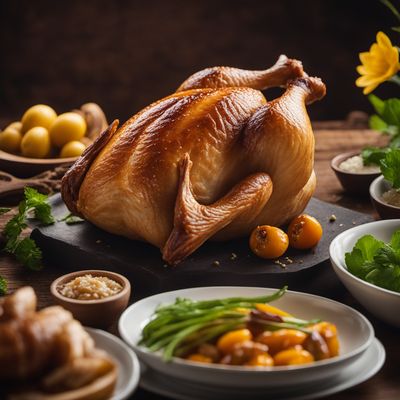
Ingredient
Goose, other slaughtering products
The Majestic Poultry
Goose, a majestic poultry delight, is known for its rich flavor, tender meat, and crispy skin. With a balance of gaminess and succulence, goose meat offers a unique culinary experience. Its versatility allows it to be prepared in various ways, from roasting to confit.
Origins and history
Goose has a long history dating back to ancient times, where it was considered a delicacy in many cultures. It has been a popular choice for festive occasions and special celebrations, symbolizing abundance and luxury. Geese were domesticated in ancient Egypt and later spread to Europe and Asia. Today, goose is still enjoyed in many traditional dishes around the world.
Nutritional information
Goose is a good source of protein and essential nutrients such as iron, zinc, and vitamin B12. It is also higher in fat compared to other poultry, which contributes to its rich flavor and moist texture. A 3.5-ounce serving of roasted goose provides approximately 250 calories.
Allergens
May contain allergens such as poultry and feathers.
How to select
When selecting a goose, look for plump birds with firm, evenly colored skin. Avoid any signs of discoloration, bruising, or strong odors. The skin should be free of feathers and have a creamy white to light yellow color. Additionally, check for a good meat-to-fat ratio, as excessive fat can result in a greasy taste.
Storage recommendations
Fresh goose should be stored in the refrigerator at a temperature below 40°F (4°C). If the goose is not going to be used within a few days, it can be frozen. To freeze, wrap the goose tightly in plastic wrap or place it in an airtight container. Properly stored, goose can be kept frozen for up to 6 months.
How to produce
Goose can be raised on a small scale by providing a suitable outdoor space for grazing and access to fresh water. It requires proper shelter and protection from predators. Consult local regulations and guidelines for raising geese in your area.
Preparation tips
To prepare goose, it is recommended to remove excess fat from the cavity and prick the skin to allow the fat to render during cooking. Roasting is a popular method, which results in crispy skin and tender meat. Goose can also be used to make confit, sausages, or pâtés. It pairs well with fruits like apples, cherries, or oranges, as well as herbs like thyme, sage, or rosemary.
Substitutions
Duck can be used as a substitute for goose, as they share similar flavor profiles and cooking methods. However, keep in mind that duck has a stronger flavor and may be fattier. Chicken can also be used as a substitute, although it will result in a milder taste.
Culinary uses
Goose is commonly used in festive dishes such as roast goose with apples, goose confit, or goose liver pâté. It is also a popular choice for traditional holiday meals, especially during Christmas or Thanksgiving. In Chinese cuisine, goose is often roasted and served with plum sauce or used in stir-fries.
Availability
Goose is commonly available in Europe, North America, and parts of Asia. It is cultivated and consumed in countries such as France, Germany, the United States, China, and Hungary.


